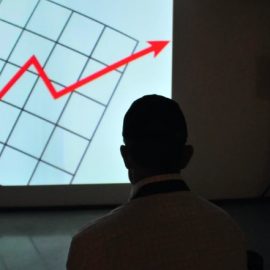

This article gives you a glimpse of what you can learn with Shortform. Shortform has the world’s best guides to 1000+ nonfiction books, plus other resources to help you accelerate your learning.
Want to learn faster and get smarter? Sign up for a free trial here .
Do you consider yourself a big-picture thinker? Do you try to understand every problem or situation holistically?
When we’re faced with a problem or a difficult decision, we tend to resort to our usual cause-and-effect, detail-oriented type of thinking. While this type of thinking is useful in some situations, it can obscure the bigger picture. As a result, the optimal solution may evade us because it lies outside the range of ideas where we are looking for it.
With this in mind, here are three ways you can apply big-picture thinking to solve problems and make decisions.
1. Systems Thinking
People naturally think in linear, cause-and-effect relationships because they’re clear and easy to understand. However, thinking in a linear fashion can cause you to become too zoomed in on the effects of a particular action or event that you fail to see the bigger picture.
By practicing to think in systems instead of linear cause-and-effect relationships, you can get a better grasp of any problem or situation. In his book The Fifth Discipline, systems scientist Peter Senge explains that systems thinking relies on feedback loops. This means when you take an action, that action creates some effect; that effect eventually circles back around and influences the cause (you), often in an unexpected way. Studying feedback is how you see the effects of your actions on the entire system, rather than just the part of it your decision directly altered.
One example of a feedback loop is an investment bubble: Investors overvalue a company or industry and invest heavily in it, which drives up its value. That causes others to overvalue it even more and invest even more, creating a loop of accelerating investment. However, this loop doesn’t last forever: Eventually, market forces catch up with the investment, the bubble bursts and the value plummets, and those investors unexpectedly lose a great deal of money.
Systems thinking through feedback loops could help you get a more accurate view of the whole situation rather than a narrow view of one event or factor.
| Systems Thinking and Decision Making When you view the world through a systems lens, you’ll see feedback loops everywhere. In fact, here’s a challenge: try thinking of any decision you make without a feedback loop of some kind. Can you think of any? You might start finding that many things influence each other in reciprocal ways. Instead of pure cause and effect, you might see that the effect actually influences the cause. -If population growth causes poverty, does poverty also cause population growth? -If the government makes a bad decision for the nation, did the nation do something to cause the government to make that bad decision? Invert your thinking. If A causes B, does B also cause A? This type of systems thinking makes blame much more complicated. It’s not an easy cause-and-effect relationship. It’s a system of interconnected parts and complicated feedback loops. |
TITLE: Thinking in Systems
AUTHOR: Donella H. Meadows
TIME: 48
READS: 192.8
IMG_URL: https://www.shortform.com/blog/wp-content/uploads/2020/11/thinking-in-systems-cover.png
BOOK_SUMMARYURL: thinking-in-systems-summary-donella-h-meadows
AMZN_ID: XYZ
2. Outside-View Thinking
Another way to engage in big-picture thinking is to look at what Daniel Kahneman, the author of Thinking, Fast and Slow, calls the outside view. The outside view is basically looking at the wide perspective of the situation before accounting for the specifics. In contrast, the “inside view” is looking at the particular details of a situation.
- For example, imagine someone tells you about their physician friend, Dr. Jones, and asks you to estimate the likelihood that Dr. Jones is a pediatrician. If you start with the outside view, you’ll ignore any details about the specific person. Instead of thinking about whether that person seems like the type to work in pediatrics, you’d try to answer the question “What percentage of doctors specialize in pediatrics overall?”
- By contrast, if you take the inside view, you’ll focus on the unique details you learn about Dr. Jones—their personality, whether they have children of their own, and so on. You’ll really be answering the question, “Is this the sort of person who is likely to be a pediatrician?”
By nature, our storytelling minds gravitate toward the inside view. Statistics are dry and abstract—digging into the nitty-gritty details of someone’s personality is much more exciting. But that natural tendency can quickly lead us astray. If we’re told that Dr. Jones loves children and worked at a summer camp for sick children during college, we might say it’s 80% likely that Dr. Jones is a pediatrician. On the other hand, if we’re told that Dr. Jones is a very serious, reserved person and has no plans to become a parent, we might swing to the other extreme and guess 2%.
The problem with this practice is that we have no way of knowing how extreme those answers are. For that, we need a base rate to give us an idea of how common it is to specialize in pediatrics in general. In reality, only about 6.5% of doctors specialize in pediatrics. A guess of 2% is closer to the mean than a guess of 80%, which means that an 80% guess is more likely to be wrong.
| Master the Outside View With a Premortem In Thinking, Fast and Slow, Daniel Kahneman advises using a “premortem” analysis to avoid the dangers of inside-out thinking. A premortem analysis is a mental exercise in which you imagine that whatever you’re working on (be it a project or a forecast) has already come to fruition—and was a complete disaster. Your goal is to come up with as many reasons as possible to explain this hypothetical “failure.” This approach is helpful because, by nature, the inside view makes a situation feel “special”—it predisposes you to focus on what makes the situation unique. That feeling can make it more difficult to notice biases in your prediction because you might assume the current situation won’t abide by the usual “rules.” For example, most newlyweds probably don’t expect to ever get divorced, despite the 40-50% divorce rate. That’s because, from the inside, the relationship feels “special” or distinct from the relationships that ended in divorce. The premortem technique can help you reorient to the outside view because assuming your answer is incorrect will likely force you to recognize that the specifics of this situation aren’t as important as the base rate. For example, if you’re predicting whether a startup will succeed, it’s tempting to take the inside view and make your forecast based on the business model or the founder’s previous business experience. However, if you try a premortem analysis, it will be easy to come up with reasons the company failed given that the failure rate for startups is roughly 90%. That sobering statistic can help remind you that even if the inside view looks like a recipe for success, the odds are stacked so strongly against new businesses that failure is much more likely. |
3. Diffuse Mode of Thinking
In A Mind for Numbers, Barbara Oakley explains that your brain naturally alternates between two modes of thinking: focused and diffuse.
According to Oakley, focused mode thinking occurs when you focus your attention on something. In the focused mode, your thoughts progress rapidly along short pathways between concepts that are closely connected in your mind. The more these pathways are used, the more developed they become, and the more quickly and easily your thoughts traverse them. Focused-mode thinking allows you to take in detailed information or solve simple problems immediately by applying the steps of a solution method that you are familiar with.
However, focused-mode thinking is susceptible to the “Einstellung effect,” which occurs when you are unable to solve a problem because the solution is outside the range of ideas where you are looking for it.
To solve such a problem, you need to switch to the diffuse-mode of thinking. Oakley explains that diffuse-mode thinking happens whenever focused mode-thinking is not happening, such as when you relax or just let your mind wander.
Diffuse mode thinking continues to subconsciously process information from previous focused-mode thinking but in a different way. It can generate creative ideas and creative solutions to difficult problems, circumventing the Einstellung effect by allowing you to mentally step away from detailed problems and see the big picture.
Oakley lists a number of ways you can access the big-picture thinking mode:
- Go for a walk or do something athletic.
- Take care of routine tasks, such as housework or laundry.
- Get some rest. Oakley asserts that your brain cannot function normally without enough sleep.
| Rapid Transitions to Diffuse Mode To take full advantage of diffuse mode, you need to divert your attention from the problem until it no longer lingers in your conscious mind. How long does this take? Oakley says it typically takes several hours. This seems reasonable for many situations, but it seems like there could be exceptions. For example, suppose you have been studying physics in your dorm room for some time when suddenly you hear a gunshot outside. The subject of physics vanishes instantly from your mind. Does a sudden shift in mental focus like this result in more time-efficient alternation between focused and diffuse thinking modes? Or does it purge the information from your conscious mind too fast for your diffuse mode to absorb it, making the diffuse-mode processing ineffective? Oakley does not address this question, and it is unclear to what extent this possibility has been investigated by the scientific community. Either way, your diffuse mode would finish processing the data sooner, whether because it received less information or got a head start on processing it. According to Oakley, once your diffuse mode has finished processing, it’s time to switch back to focused mode. Thus, we infer that you should refocus on the problem sooner after a sudden transition to diffuse mode than after a gradual one. |
TITLE: A Mind for Numbers
AUTHOR: Barbara Oakley
TIME: 72
READS: 136.9
IMG_URL: https://www.shortform.com/blog/wp-content/uploads/2021/05/a-mind-for-numbers-cover.png
BOOK_SUMMARYURL: a-mind-for-numbers-summary-barbara-oakley
AMZN_ID: XYZ
Final Words
Big-picture thinking means taking a bird’s eye view of a problem or a situation instead of zooming in on the details. While the details are also important, they can obstruct your view of the bigger picture.
If you enjoyed our article about big-picture thinking, check out the following suggestions for further reading:
Humans and computers face many of the same problems: We both have a never-ending stream of things we want to do and a limited amount of time and energy to do them. Is it possible that the age-old question of how best to live has already been solved by computer engineers? In Algorithms to Live By, science writer Brian Christian and Berkeley psychologist Tom Griffiths team up to prove that computer science is a fount of unconventional wisdom with practical value in many areas of human life.
In Six Thinking Hats, doctor and psychologist Edward de Bono takes the phrase “put your thinking cap on” to a new level. As De Bono explains, our normal thinking process is a hopeless tangle of six different types of thinking. We can improve the quality and efficiency of our decisions by untangling these six thinking types (symbolized by six hats of different colors) and deploying them more consciously.

Want to fast-track your learning? With Shortform, you’ll gain insights you won't find anywhere else .
Here's what you’ll get when you sign up for Shortform :
- Complicated ideas explained in simple and concise ways
- Smart analysis that connects what you’re reading to other key concepts
- Writing with zero fluff because we know how important your time is






